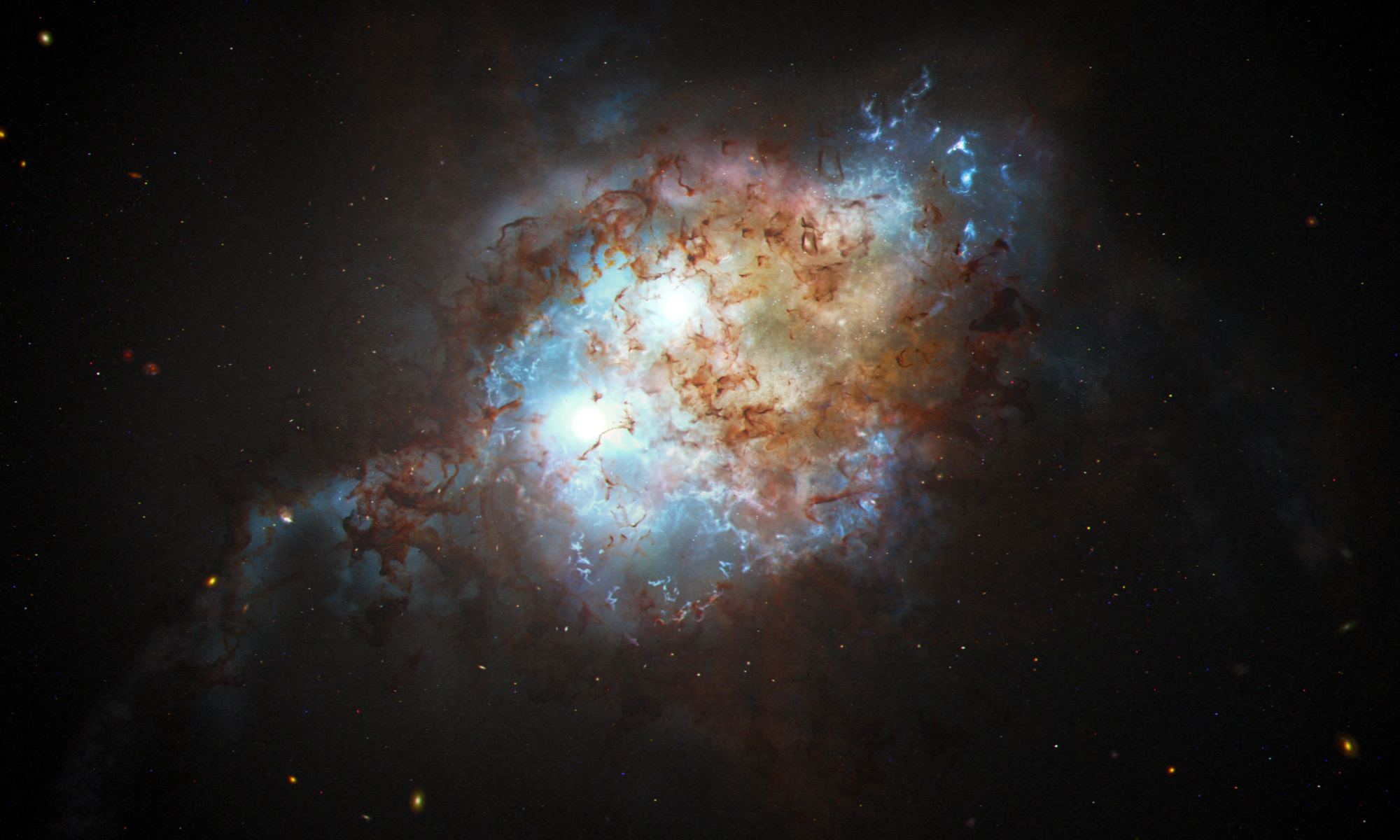When it comes to the brightest, most powerful objects in the Universe, not much can beat a Quasar. A Gamma Ray Burst from a supernova might be more energetic, but doesn’t last very long. Quasars, by comparison, can churn out 1000 times the radiation of the Milky Way, and keep doing it for hundreds of millions of years.
They get all this energy from the supermassive black holes that live at the center of galaxies. As material falls towards the black hole, an accretion disk forms around it: a swirling cloud of energetic material which heats up through friction and releases electromagnetic radiation. The resulting Quasar can be so bright it drowns out the light from the rest of its galaxy from our perspective.
On April 5th, researchers announced the discovery of a rare double quasar in the early Universe. The two quasars are gravitationally bound, spiraling in towards each other. Their host galaxies are in the process of merging, and the supermassive black holes generating the quasars will also eventually collide and merge.
“We’re starting to unveil this tip of the iceberg of the early binary quasar population,” said Xin Liu, a researcher from the University of Illinois at Urbana-Champaign, in a press release. “This is the uniqueness of this study. It is actually telling us that this population exists, and now we have a method to identify double quasars that are separated by less than the size of a single galaxy.”

As bright as quasars are, detecting – and interpreting – the signals received from distant quasars is not easy. This pair of quasars existed just three billion years after the Big Bang, during a time period known as cosmic noon: the era between 10 and 11 billion years ago when star formation in the Universe was at its peak. They are very, very distant objects.
It took a large collaboration and a half dozen telescopes to achieve this result. The two objects are named after their Sloan Digital Sky Survey designations J0749 + 2255, and were identified as a double quasar using the European Space Agency’s Gaia spacecraft. Confirming the characterization of the object required observations in infrared from both the Hubble Space Telescope and the W.M. Keck Observatories in Hawaii. Additional information about the objects in other wavelengths were gathered using International Gemini Observatory (optical and near-infrared), the Karl G. Jansky Very Large Array (radio), and NASA’s Chandra X-ray Observatory (X-ray).
Like putting together a puzzle, each wavelength offered different information about the quasars, and helped researchers understand what was going on in this distant binary galaxy system.
Hubble’s powerful resolution also allowed them to rule out the possibility that they were actually just seeing the same quasar twice due to the wonky effects of gravitational lensing.
The double quasars J0749 + 2255 are so close together that they are separated by less than the space of a single galaxy, so resolving them at a distance of 10-11 billion light years away is an incredible feat.
NASA’s upcoming Nancy Grace Roman telescope will be an ideal tool for finding more examples of double quasars. It will have a similar resolution to Hubble, but with a wider field of view to image more of the sky at once.
With a larger sample size, astronomers will be able to make better models of galactic evolution in the early Universe.
Learn More:
“Hubble Unexpectedly Finds Double Quasar in Distant Universe.” NASA.
Yu-Ching Chen et al. “A close quasar pair in a disk–disk galaxy merger at z = 2.17.” Nature.
Featured Image: An artist’s concept of two quasars residing in the cores of two galaxies in the process of merging. Credits: NASA, ESA, Joseph Olmsted (STScI).


This short take was helpful to me (so I didn’t have to read the full paper):
“However, Hubble’s sharp resolution alone isn’t good enough to go looking for these dual light beacons. The researchers enlisted Gaia, which launched in 2013, to pinpoint potential double-quasar candidates. Gaia measures the positions, distances, and motions of nearby celestial objects very precisely. But in a novel technique, it can be used to explore the distant universe. Gaia’s huge database can be used to search for quasars that mimic the apparent motion of nearby stars. The quasars appear as single objects in the Gaia data because they are so close together. However, Gaia can pick up a subtle, unexpected “jiggle” that mimics an apparent change in position of some of the quasars it observes.
In reality, the quasars aren’t moving through space in any measurable way. Instead, their jiggle could be evidence of random fluctuations of light as each member of the quasar pair varies in brightness on timescales of days to months, depending on their black hole’s feeding schedule. This alternating brightness between the quasar pair is similar to seeing a railroad crossing signal from a distance. As the lights on both sides of the stationary signal alternately flash, the sign gives the illusion of “jiggling.”
Another challenge is that because gravity warps space like a funhouse mirror, a foreground galaxy could split the image of a distant quasar into two, creating the illusion it was really a binary pair. The Keck telescope was used to make sure there’s no lensing galaxy in between us and the suspected double quasar.”
[“Hubble unexpectedly finds double quasar in distant universe”, NASA/Goddard Space Flight Center, ScienceDaily]